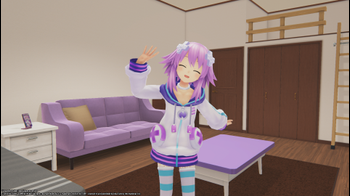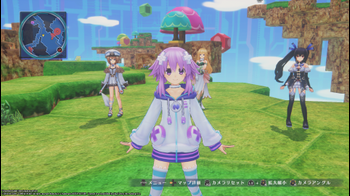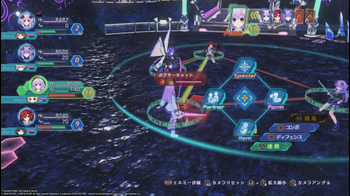
Megadimension Neptunia VIIR Review
More than two years after originally covering it for the site, Megadimension Neptunia VII remains, in my opinion, the pinnacle of the series. It features entertaining writing, likable characters, nice visuals, and above all, an amazing soundtrack I still constantly listen to this day.
That brings us to Megadimension Neptunia VIIR. This is for all intents and purposes a remaster of the original entry with plenty of additional content layered on top. Due to this, and since I already covered the first release, I am not really going to get into that particular portion of the experience. I recommend checking out my review for Megadimension Neptunia VII since it all can be found here.
VIIR begins in a bit of an odd way by presuming you had already beaten the game. As a disembodied protagonist, you are greeted by a sprite who praises you for saving the different dimensions. You can approach this in one of two ways: either the game is assuming you’re picking this game up for the second time, or everything is told through a flashback sequence.
Once you enter the “Player’s Room” (an actual bedroom/studio apartment of sorts), you are greeted by Histoire who provides a quick rundown of how this area works including how to play the game properly.
VIIR also alludes to the fact the game now features (limited) VR functionality. The game will begin by asking you to hook up your PlayStation VR headset where you’ll be able to enjoy all of the game’s event cutscenes through this 360-degree view. Otherwise, you’ll be using the right analog stick to move the player’s head around like moving it up and down to nod or left and right to decline. Meanwhile, the left analog stick lets you lean your character around spatially.
You will also get the chance to interact with the different Goddesses in your room through the headset (or your controller) while also having the ability to redecorate the place using Room Objects you have collected over the course of the game and through these events. Whether it’s a new piece of furniture or different figures, these objects cause the Goddesses to either comment on or interact with them in some fashion.
Otherwise, you’re playing the same game that is interstitched with these same VR cutscenes, many of them pertinent to whatever is happening in the game. I wouldn’t exactly call them seamless - a lot of it is straight up 4th wall breaking (like characters asking if you’re playing a game called “Megadimension Neptunia VII”), but it’s a neat feature.
Some of it even spoils a little of what comes later, but honestly, you’d only know if you were already familiar with the story. Otherwise, they’re harmless and even rather charming episodes that occur at the end of each story chapter. If anything, it’s a sign they could do far more with the technology.
While I wasn’t able to try this out myself in the final release as I don’t own a PSVR headset, I did get a chance to see it in action last year during Idea Factory’s press event in early December. I found it to be pretty neat, all things considered, even if it is pretty light on interactivity. You’re mostly just sitting there listening to the characters speak in your direction.
The only real downside is if you’re not fast enough with the controller, you may miss out on something that’s directly out of your field of view since the game expects you to be constantly moving your head around. Plus, every time you’re about to start a scene, the game asks you to put your headset on, which can be a little tedious.
There's more bad news. Because the developers decided to add VR functionality, they had to drop down the framerate as a result. This means the game now runs at 30FPS compared to the original game running at 60FPS. It’s a noticeable reduction especially in combat, which is a shame.
Also, there is no manual save feature anymore - everything is done through auto-saves, which can be a real pain if you’re the type to experiment with your progress. The good news is, this means never having to leave the dungeon to save, and in the event of a game crash, you won’t have to worry about losing any progress since it saves after every battle and when you return to the Player’s Room. I should note none of your previous save data or DLC will carry over to this new release.
Outside of the framerate adjustment and a streamlined menu, the only big change in the gameplay department is the way the combat system operates. Before, you would set your combos inside of the character menu and then proceed to hammer away at the enemy until your AP (or action points) were used up. Here, a lot of this is done inside the battle itself. Once you move within range of an enemy, you will be given the option to either use a special skill or begin the combo. If you choose Combo, you will proceed to enter the Combo setting screen. This lets you set as many Combo Skills as your AP allows.
Once you are done setting things up, all you have to do is hit R2 to activate the combo you have created. Using fewer skills per turn lets you bank the AP until the next initiative, which is great if you’re dealing with several enemies. You also only accumulate a certain amount of AP and SP each turn, but the good news is as you level up, this amount increases so it hardly becomes a bother once you near the end of the story.
Another interesting change is the way in which items work. Rather than simply consuming an item like you would normally, there is this new system called Item Skills. You have the choice to use the item as-is, or use several items at once in order to strengthen or alter its effects. This can really help out in a pinch (and when you don’t want to waste turns spamming low-level items).
All of this adds an extra layer of depth to the core mechanics of the game. I should also mention you will no longer be able to deal the same amount of damage if you attack two enemies that are close to one another. Instead, each character has a cone of attack in front of them, with the red portion indicating the maximum amount of damage while the yellow delivering a reduced amount. So you have to be careful with where you’re targeting, but thankfully, the enemy lights up to indicate whether they’re in the red or not.
I’m of two minds when it comes to these changes to the battle system. Although I appreciate the granularity it presents for those who want more control over the action such as myself, I wish it allowed me to set macros so I can still hammer away at an enemy without having to confirm everything over and over. It makes it lose some of the more fast-paced action from its predecessor.
An additional change is up to three other characters will now run around with you while out on the field. This means while Neptune is fun bouncing around like a kangaroo, Nepgear is right behind her making similar remarks. It’s kind of nice having them around instead of just disappearing into an alternate dimension while outside of combat. Bonus points: I had absolutely no issue with the pathfinding like I did in Cyberdimension Neptunia.
Finally, we get to the visuals. Thanks to the switch in engines, the level of detail received a nice degree of improvement. Gone are those traces of bloom and washed out colors that hurt the appearance of the original. In its place is a far cleaner design that gives it more of a current-gen feel, helping the game to run even smoother than it did initially. Character models have also been redone to blend in nicely with the improved backdrop. As far as the audio is concerned, there are several new themes that have been added (including several new boss themes) on top of what is already an already stellar soundtrack.
Neptunia fans will more than likely pick this game up no matter what I have to say about it because we’re just that kind of crowd. However, for those who have been sitting on the fence with an interest in this super niche series may want to check Megadimension Neptunia VIIR out.
It’s pound for pound the best the series has been, illuminating all of its strong points in a more robust and better-looking package. While a few of these changes won’t be everyone’s cup of tea, fans will appreciate the added interactivity and quality of life improvements. I just have a hard time recommending this if you already beat the original Megadimension VII.


